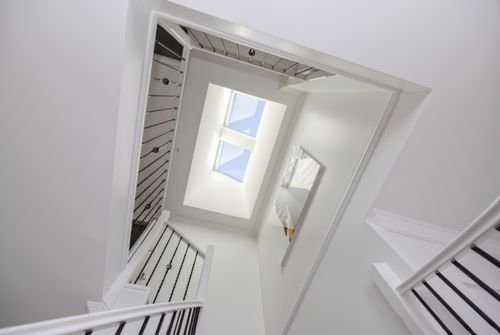Proper ventilation is essential in maintaining a healthy indoor environment. It helps regulate air quality, control temperature and humidity, and ensure the comfort of occupants. With various types of ventilation systems available, it can be difficult to choose the right one for a building. In this article, we’ll explore the different types of ventilation systems and discuss the unique benefits each one offers.
1. Natural Ventilation
Natural ventilation is one of the oldest and most energy-efficient methods of air circulation. It relies on natural forces like wind and buoyancy to introduce fresh air into a building and expel stale air. This can be achieved through open windows, vents, and strategically placed openings in the building’s structure.
How It Works:
- Wind pressure pushes outdoor air into the building through windows or vents.
- The warm air inside rises and escapes through the building’s exhaust outlets (often on the roof), drawing in cooler outdoor air.
Benefits of Natural Ventilation:
- Energy efficiency: Reduces the need for mechanical cooling and heating.
- Cost-effective: Minimizes energy bills since no electricity is required.
- Improved air quality: Promotes fresh airflow, reducing indoor pollutants.
However, natural ventilation is most effective in mild climates and may not work as efficiently in extreme weather conditions or in buildings without proper airflow design.
2. Mechanical Ventilation
Mechanical ventilation uses fans and ductwork to circulate air throughout a building. This system can be used to exhaust stale air and introduce fresh outdoor air. Mechanical ventilation is most common in modern buildings, where natural ventilation may not be sufficient due to energy efficiency codes or building design.
There are two main types of mechanical ventilation systems:
-
Exhaust Ventilation Systems: These systems pull indoor air out of a building, creating negative pressure that draws fresh outdoor air through openings or vents. They’re typically used in areas like kitchens, bathrooms, and laundries.
-
Supply Ventilation Systems: These systems push fresh outdoor air into a building while exhausting stale air through other vents. The fresh air helps balance indoor pressure and prevents pollutants from accumulating inside.
-
Balanced Ventilation Systems: These systems provide a balanced intake of fresh outdoor air and exhaust of indoor air, often utilizing heat exchangers to transfer heat between incoming and outgoing air. This ensures energy efficiency while maintaining air quality.
Benefits of Mechanical Ventilation:
- Controlled airflow: Ensures consistent and reliable ventilation, especially in sealed buildings.
- Improved indoor air quality: Filters out pollutants, allergens, and moisture, creating a healthier living or working space.
- Temperature control: Some systems, like heat recovery ventilators (HRVs) and energy recovery ventilators (ERVs), also help with temperature regulation.
The primary downside of mechanical ventilation is its energy consumption, especially when heating or cooling the incoming air.
3. Hybrid Ventilation
Hybrid ventilation combines the best aspects of both natural and mechanical ventilation systems. It utilizes natural ventilation as much as possible but switches to mechanical ventilation when necessary, typically in extreme weather conditions or during times of low outdoor airflow.
How It Works:
- During favorable weather conditions, the system uses natural airflow to ventilate the building.
- When outdoor conditions are unfavorable (e.g., during high heat, humidity, or low wind), mechanical ventilation kicks in to maintain a consistent indoor environment.
Benefits of Hybrid Ventilation:
- Energy efficiency: It reduces energy consumption by relying on natural ventilation when possible.
- Flexibility: Provides reliable ventilation in all weather conditions.
- Cost-effective: Offers a balance between the operational costs of natural and mechanical systems.
Hybrid ventilation is often found in buildings that require high energy efficiency, like office buildings, schools, and hospitals.
4. Heat Recovery Ventilation (HRV) and Energy Recovery Ventilation (ERV)
HRV and ERV systems are types of mechanical ventilation that focus on energy conservation by recovering heat (HRV) or both heat and moisture (ERV) from exhaust air to condition incoming fresh air. These systems are typically installed in energy-efficient buildings and are designed to reduce heating and cooling costs.
- HRVs are especially effective in colder climates, as they transfer heat from outgoing stale air to pre-warm incoming fresh air.
- ERVs are ideal for hot, humid climates because they transfer both heat and moisture, helping to maintain comfortable humidity levels indoors.
Benefits of HRV and ERV:
- Energy savings: Significantly reduces the need for additional heating or cooling.
- Improved comfort: Helps maintain consistent indoor temperatures and humidity levels.
- Better air quality: Removes contaminants and provides continuous fresh air.
5. Positive Pressure Ventilation
A positive pressure ventilation system uses fans to force outdoor air into the building, creating a slight pressure difference. This prevents the ingress of outside pollutants, as the system pushes fresh air into the building and forces air out through vents and other openings.
How It Works:
- The system draws outdoor air through filters before pumping it into the building, ensuring that the air is clean and free from contaminants.
- The pressure difference keeps the building’s interior at a higher pressure than the outside, which helps to prevent dirt, dust, and other pollutants from entering.
Benefits of Positive Pressure Ventilation:
- Improved air quality: Filters incoming air, removing pollutants and allergens.
- Pest and moisture control: The pressure difference can prevent moisture and pests from entering the building.
- Ideal for allergy sufferers: It creates a controlled environment with fresh, clean air.
6. Displacement Ventilation
Displacement ventilation is a less common type of ventilation that introduces fresh air at low velocities near the floor, which gradually rises to displace the warmer, polluted air that collects near the ceiling.
How It Works:
- Fresh air is supplied through vents located near the floor.
- The cooler air pushes the warmer, polluted air upward and out of the room, where it is removed by exhaust outlets.
Benefits of Displacement Ventilation:
- Energy efficiency: It operates at lower air velocities, which can save energy compared to traditional systems.
- Enhanced comfort: Since air is introduced at a lower level, the indoor environment tends to be more comfortable and draft-free.
- Improved air quality: More effective at removing pollutants from the occupied zone.
Conclusion
Each type of ventilation system offers distinct advantages based on the building’s requirements, climate, and energy efficiency goals. While natural ventilation is cost-effective and environmentally friendly, mechanical systems provide more reliable airflow, especially in modern, airtight buildings. Hybrid systems combine the benefits of both, while advanced systems like HRVs and ERVs focus on energy recovery and humidity control.
Choosing the right ventilation system requires careful consideration of factors such as the building’s design, climate, energy goals, and the level of indoor air quality desired. By understanding the different types of ventilation and their benefits, you can make an informed decision that optimizes both comfort and energy efficiency for your space.





